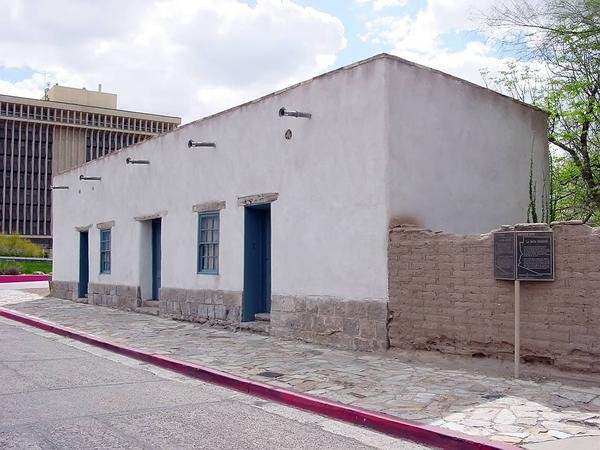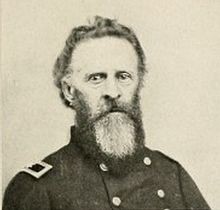Exchange at the Presidio Monument-Capture of Tucson
Introduction
Text-to-speech Audio
On December 16, 1846, Mexican forces in the garrison of Fort Tucson abandoned the fort and town in the face of the oncoming Mormon Battalion during the Mexican War. The 200 man-force decided not to take on the 360 (out of the original 500) man-force of the Battalion as soon as they discovered the latter was coming. The Battalion captured the fort and town with no bloodshed and raised the American flag at the Presidio (fort) the same day. Days later the Battalion left for California, Tucson was recaptured by Mexican forces, then re-abandoned by the war's end. In 1993 a monument of the flag raising was erected and dedicated by the LDS/Mormon church.
Images
1860s painting of the Mormon Battalion in the Sonoran Desert of Arizona

Exchange at the Presidio Monument

What remains of the Presidio today

General Philip St. George Cook as he looked during the Civil War

Backstory and Context
Text-to-speech Audio
Having marched from Council Bluffs in Iowa earlier in 1846 during the early stages of the Mexican War, the 500 man-force of the Mormon Battalion had shrunk to under 400 in Santa Fe due to illness. Commanded by General Philip St. George Cooke, the Battalion headed towards modern-day Arizona to capture Tucson before heading to their ultimate objectives in San Diego and Los Angeles in California. On December 16, 1846, the Battalion reached the outskirts of the town with 360 men and prepared to attack.
In Tucson, specifically in Fort (Presidio) Tucson, 200 men of the local Mexican forces commanded by Antonio Comaduron, decided to abandon the town rather than fight, since they were outnumbered. The Presidio and town had been in existence since 1776. They fled with some locals they persuaded to leave by saying the American forces would destroy the town and kill the people. As the Battalion entered the town and captured the fort with no resistance, they had to persuade the people that they meant no harm. Later that day, the American flag was raised in the grounds of the Presidio by Christopher Layton and Jefferson Hunt.
During the occupation, the Battalion traded clothes, buttons and pins for food. The only gunfire to take place occurred a few days after the capture when local Mexican civilians were coming into town at night and mistaken for Mexican soldiers. No one was hit. Other Mexican forces around Tucson were also driven off by the Battalion.
The Battalion left Tucson for California after a couple of days. The town was recaptured by Mexican forces, only to be abandoned again by them before the war's end.
In 1993, the LDS church erected a monument on the grounds of the former Presidio, which are now the grounds of the County Courthouse and it was dedicated. The monument depicts Layton and Hunt raising the flag while also trading with local Teodoro Ramirez.
As the Battalion marched from Santa Fe, New Mexico to San Diego, their route would later be used by many pioneers during the latter half of the 19th century and helped in the populating of New Mexico, Arizona and Southern California. Throughout their march, the Battalion members would carve out trails in rocky areas for wagons to go through.
In Tucson, specifically in Fort (Presidio) Tucson, 200 men of the local Mexican forces commanded by Antonio Comaduron, decided to abandon the town rather than fight, since they were outnumbered. The Presidio and town had been in existence since 1776. They fled with some locals they persuaded to leave by saying the American forces would destroy the town and kill the people. As the Battalion entered the town and captured the fort with no resistance, they had to persuade the people that they meant no harm. Later that day, the American flag was raised in the grounds of the Presidio by Christopher Layton and Jefferson Hunt.
During the occupation, the Battalion traded clothes, buttons and pins for food. The only gunfire to take place occurred a few days after the capture when local Mexican civilians were coming into town at night and mistaken for Mexican soldiers. No one was hit. Other Mexican forces around Tucson were also driven off by the Battalion.
The Battalion left Tucson for California after a couple of days. The town was recaptured by Mexican forces, only to be abandoned again by them before the war's end.
In 1993, the LDS church erected a monument on the grounds of the former Presidio, which are now the grounds of the County Courthouse and it was dedicated. The monument depicts Layton and Hunt raising the flag while also trading with local Teodoro Ramirez.
As the Battalion marched from Santa Fe, New Mexico to San Diego, their route would later be used by many pioneers during the latter half of the 19th century and helped in the populating of New Mexico, Arizona and Southern California. Throughout their march, the Battalion members would carve out trails in rocky areas for wagons to go through.
Sources
1. "The Historical Marker Database," Exchange at the Presidio, accessed November 18, 2016.
http://www.hmdb.org/marker.asp?marker=73983
2. "Exchange at the Presidio-Tucson, Arizona," Waymarking website, accessed November 18, 2016.
http://www.waymarking.com/waymarks/WMHHJA_Exchange_At_The_Presidio_Tucson_Arizona
3. "Exchange at the Presidio-Tucson, Arizona," Mormon Battalion website, accessed November 18, 2016.
http://www.mormonbattalion.com/File/29a54276-133e-44f7-9870-1bac6df25789
4. Associated Press, "Tucson Statue to Honor Mormon Battalion," Deseret News, January 5, 1995, accessed November 18, 2016.
http://www.deseretnews.com/article/396862/TUCSON-STATUE-TO-HONOR-MORMON-BATTALION.html?pg=all
5. Kenneth Mays, "Picturing History: the Mormon Batallion at Tucson," Deseret News, March 25, 2015, accessed November 18, 2016.
http://www.deseretnews.com/article/865624906/Picturing-history-The-Mormon-Battalion-at-Tucson.html?pg=all
Books
6. Justin Harvey Smith, The War with Mexico, 2 vol., Gloucester, Mass., P. Smith, 1963 [©1919], Gloucester, Mass., P. Smith, (Pulitzer Prize winner. Full text online), accessed November 18, 2016.
http://www.worldcat.org/title/war-with-mexico/oclc/795557111?referer=di&ht=edition
7. John Bret Harte, Tucson: Portrait of a Desert Pueblo, 2001, American Historical Press, Sun Valley, California, accessed November 18, 2016.
http://www.worldcat.org/title/tucson-portrait-of-a-desert-pueblo/oclc/48879744?referer=di&ht=edition
8. Henry F. Dobyns, Spanish Colonial Tucson: a demographic history, 1976, University of Arizona Press, Tucson, accessed November 18, 2016.
http://www.worldcat.org/title/spanish-colonial-tucson-a-demographic-history/oclc/2191790&referer=brief_results
9. Roy P. Drachman, From Cowtown to Desert Metropolis: Ninety Years of Arizona Memories. 1999, Whitewing Press, San Francisco, accessed November 18, 2016.
http://www.worldcat.org/title/from-cowtown-to-desert-metropolis-ninety-years-of-arizona-memories/oclc/42950070&referer=brief_results
